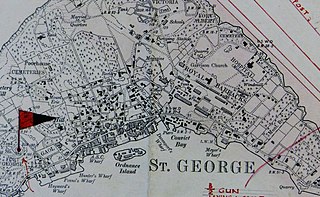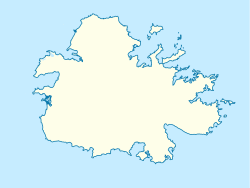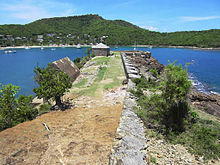
Saint Paul, officially the Parish of Saint Paul, is a parish of Antigua and Barbuda on the island of Antigua. Saint Paul borders Saint Peter and Saint John to the north, Saint Mary to the west, and Saint Philip to the east. Saint Paul is dominated by farmland in the north, with various creeks and Potworks Dam marking its northern border, and low-lying hills to the south, defining its western border with Saint Mary. The largest city fully within the parish is Liberta, the fourth largest city in the country. The parish capital, and the location of the parish church, is Falmouth. The main economic and tourism hub of the parish is English Harbour. Saint Paul was created with the other five original parishes on 11 January 1692. It had a population of 9,004 in 2018.

Royal Navy Dockyards were state-owned harbour facilities where ships of the Royal Navy were built, based, repaired and refitted. Until the mid-19th century the Royal Dockyards were the largest industrial complexes in Britain.

His Majesty's Naval Base, Portsmouth is one of three operating bases in the United Kingdom for the Royal Navy. Portsmouth Naval Base is part of the city of Portsmouth; it is located on the eastern shore of Portsmouth Harbour, north of the Solent and the Isle of Wight. For centuries it was officially known as HM Dockyard, Portsmouth: as a Royal Dockyard, Portsmouth functioned primarily as a state-owned facility for building, repairing and maintaining warships; for a time it was the largest industrial site in the world.

Canadian Forces Base (CFB) Halifax is Canada's east coast naval base and home port to the Royal Canadian Navy Atlantic fleet, known as Canadian Fleet Atlantic (CANFLTLANT), that forms part of the formation Maritime Forces Atlantic (MARLANT).

Ireland Island is the north-westernmost island in the chain which comprises Bermuda. It forms a long finger of land pointing northeastwards from the main island, the last link in a chain which also includes Boaz Island and Somerset Island. It lies within Sandys Parish, and forms the northwestern coast of the Great Sound. It is regarded as one of the six principal islands of Bermuda, and part of the West End of the archipelago.

Nelson's Dockyard is a cultural heritage site and marina in English Harbour, located in Saint Paul Parish on the Caribbean island of Antigua, in Antigua and Barbuda. It was built was built in the early 18th century and abandoned by the British Navy in 1889.

Haulbowline is an island in Cork Harbour off the coast of Ireland. The world's first yacht club was founded on Haulbowline in 1720. The western side of the island is the main naval base and headquarters for the Irish Naval Service, with the eastern side previously used for heavy industry and later redeveloped as a park.

HMD Bermuda was the principal base of the Royal Navy in the Western Atlantic between American independence and the Cold War. The Imperial fortress colony of Bermuda had occupied a useful position astride the homeward leg taken by many European vessels from the New World since before its settlement by England in 1609. French privateers may have used the islands as a staging place for operations against Spanish galleons in the 16th century. Bermudian privateers certainly played a role in many English and British wars following settlement, with its utility as a base for his privateers leading to the Earl of Warwick, the namesake of Warwick Parish, becoming the most important investor of the Somers Isles Company. Despite this, it was not until the loss of bases on most of the North American Atlantic seaboard threatened Britain's supremacy in the Western Atlantic that the island assumed great importance as a naval base. In 1818 the Royal Naval Dockyard, Bermuda officially replaced the Royal Naval Dockyard, Halifax, as the British headquarters for the North America Station (which would become the North America and West Indies Station after absorbing the Jamaica Station in 1830.

Sheerness Dockyard was a Royal Navy Dockyard located on the Sheerness peninsula, at the mouth of the River Medway in Kent. It was opened in the 1660s and closed in 1960.

HMS Mediator was a Roebuck-class 44-gun fifth rate of the Royal Navy. She was built and served during the American War of Independence, but was reduced to a storeship and renamed HMS Camel in 1788. She spent the French Revolutionary and part of the Napoleonic Wars in this capacity before being broken up in 1810.

The Bermuda Garrison was the military establishment maintained on the British Overseas Territory and Imperial fortress of Bermuda by the regular British Army and its local militia and voluntary reserves from 1701 to 1957. The garrison evolved from an independent company, to a company of Royal Garrison Battalion during the American War of Independence, and a steadily growing and diversifying force of artillery and infantry with various supporting corps from the French Revolution onwards. During the American War of Independence, the garrison in Bermuda fell under the military Commander-in-Chief of America. Subsequently, it was part of the Nova Scotia Command until 1868, and was an independent Bermuda Command from then until its closure in 1957.
The Trincomalee Garrison is a common name used for collection of military bases of the Sri Lanka Army located in and around the Fort Fredrick and the town of Trincomalee in the Eastern Province. Due to the large natural harbor, it is one of the oldest military garrisons in Sri Lanka and has been occupied by the Portuguese, Dutch, French and the British. Known as Trincomalee Fortress during World War II.
Sri Lanka Navy (SLN) Dockyard is the largest naval base of the Sri Lanka Navy and a major shipyard located in Trincomalee, Sri Lanka. Established by the British as the Royal Naval Dockyard, Trincomalee, it was home to the East Indies Station of the Royal Navy during World War II. Since the withdrawal of the Royal Navy, the Royal Ceylon Navy took over dockyard. It became the home base of the RCyN fleet and today it is home to the Eastern Naval Command and the Naval and Maritime Academy of the Sri Lanka Navy.

Prospect Camp, also referred to as Prospect Garrison, was the main infantry camp of the Bermuda Garrison, the military force stationed in the Imperial fortress of Bermuda. It also contained Fort Prospect, Fort Langton, and Fort Hamilton, as well as being the base for mobile artillery batteries, manned by the Royal Artillery. Outlying parts of the camp were disposed of in the early decades of the Twentieth Century as the garrison in Bermuda was reduced. The core area, including the barracks, passed to the local government when the garrison was withdrawn in 1957.

Rosia Bay is the only natural harbour in Gibraltar, the British Overseas Territory at the southern end of the Iberian Peninsula. Formerly referred to as Rosia Harbour, it is located on the southwest side of Gibraltar. Rosia Bay was the site of the Royal Navy Victualling Yard complex which was constructed in the early 19th century, allowing vessels to anchor and obtain provisions, including food and water. Vice Admiral Horatio Nelson obtained supplies for his Mediterranean Fleet at Rosia Bay. It was to that same anchorage that his vessel HMS Victory was towed after Nelson's death in the 1805 Battle of Trafalgar. The area is also the location of gun batteries, including Parson's Lodge Battery at the south end of the bay and Napier of Magdala Battery at the north end. In the 21st century, Rosia Bay was the focus of controversy following the government's demolition of the historic Rosia Water Tanks and construction of the affordable housing development Nelson's View, which necessitated the relocation of the owners of the adjacent 19th century Rosia Cottages.

The Glorious Revolution of 1688 rearranged the political map of Europe, and led to a series of wars with France that lasted well over a century. This was the classic age of sail; while the ships themselves evolved in only minor ways, technique and tactics were honed to a high degree, and the battles of the Napoleonic Wars entailed feats that would have been impossible for the fleets of the 17th century. Because of parliamentary opposition, James II fled the country. The landing of William III and the Glorious Revolution itself was a gigantic effort involving 100 warships and 400 transports carrying 11,000 infantry and 4,000 horses. It was not opposed by the English or Scottish fleets.

St. George's Garrison was the first permanent military camp of the Bermuda Garrison established in the British colony and Imperial fortress of Bermuda, with construction of Old Military Road and the original Royal Barracks commencing during the war between Britain and France that followed the French Revolution. It would remain in use until 1957, when it was transferred to the civil (colonial) government with most of the other Admiralty and War Office properties in Bermuda.

Shirley Heights is an historic military compound in Antigua. It was built in the 1780s to protect the Naval Dockyard in English Harbour. It is part of Nelson's Dockyard National Park and part of a UNESCO World Heritage Site.

Fort Berkeley is a historic military fort on the island of Antigua. It is located at the entrance to English Harbour in Saint Paul parish. The fort was built in 1704 and expanded in the mid 18th century. It is part of Nelson's Dockyard National Park and the Antigua Naval Dockyard and Related Archaeological Sites UNESCO World Heritage Site.

The Antigua Naval Dockyard and Related Archaeological Sites is a 255 ha UNESCO World Heritage Site in Saint Paul Parish, Antigua, Antigua and Barbuda. It constitutes a collection of Georgian era naval structures, namely a naval dockyard and related supporting compounds. This maritime complex was established during a period marked by intense competition among European nations vying for dominance at sea to secure authority over the profitable sugar-producing islands in the Eastern Caribbean.


















